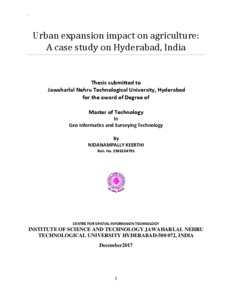Urban expansion impact on agriculture: A case study on Hyderabad, India
Abstract
Capital cities of the states of India have become centers of development and growth due to industrial concentration and source of employment for migrants. Infrastructure development is a major attraction for migrant labor. Apart from these the natural growth of the urban sprawl has much to contribute from the suburban villages and towns changing their role as suppliers to the urban population. The land use in these peri-urban areas has not only changed to be a supply link but also ready to be merged into the sprawl. The major goal of this study was to investigate the land use changes in urban and peri-urban Hyderabad and its influence on land use and land cover changes using Landsat 8 data and IRS-P6 data along with ground information. The main source of wastewater was the Musi River, which collects large volumes of city discharges while it runs through the city. During the period 2005 – 2016, the wastewater irrigated area within the environs of the Musi River, increased from 15,553 to 20,573 hectares with concurrent expansion of the city boundaries from 38,863 to 80,111 hectares. Opportunistic shifts in land use, especially related to wastewater irrigated agriculture, was a response to the demand for fresh vegetables and easy access to markets, exploited mainly by migrant populations. While the wastewater irrigated agriculture contributes to income security of the marginal groups, it supplements the food basket of many city dwellers. The IRS-P6, Landsat 8 data and advanced methods such as spectral matching techniques are ideal for quantifying urban expansion and associated land use changes, and are useful for urban planners and decision makers alike

